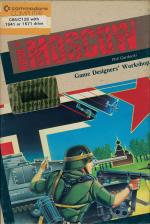
C&VG
 1st January 1988
1st January 1988
Categories: Review: Software
Publisher: Electronic Arts
Machine: Commodore 64/128
Published in Computer & Video Games #75
Road To Moscow
In this game of the Eastern Front in World War Two the single player takes the Axis forces (the Germans and their allies) against the computer as the Russians on a map that covers the whole Eastern Front from Finland to the Crimea (achieved by having East at the top of the map so that the Germans attack upwards).
The playing mechanism could hardly be more simple: in the order phase, each Corps is selected by joystick and moved with up to five directional changes, then in the movement phase they all attempt to move together.
The computer calculates how far such a unit could actually move over that type of ground in those weather conditions.

If an enemy is in the given path it is attacked, and units which are attacked too heavily lose strength, retreat, or are wiped out.
There are no rules for formations higher than a Corps, but each must keep within reasonable distance of an Army Group headquarters or run into supply problems. Putting movement and combat together like this speeds the game up considerably, and creates the realistic problem of avoiding traffic jams. Even at two moves to a month it is possible to play a year-long scenario in an evening.
The game reflects the only change the Germans had of winning on the Eastern Front, a quick victory before the Soviets could build up overwhelming forces, and before the dreaded Russian winter could take effect.

On the campaign scenario, which covers the entire war, the Russians will surrender only if every city on the screen (Moscow, Stalingrad, Leningrad and everything west of them) are captured. Since this is just about impossible, there are also four one-year scenarios for each year from 1941, with their own victory conditions.
The player has to concentrate on two essentials: keeping his crucial Panzer forces well forward, but in supply and not so heavily engaged that they become useless, and judging when to call off an offensive and prepare defensive positions for the winter.
The end of the game, by the surrendering of either side, can sometimes be triggered by accident, which is annoying.
The game is meant to save directly onto the playing disk; a good idea, but the review copy didn't work. But these are minor grumbles at which is a good computer wargame with an excellent playing mechanism.







